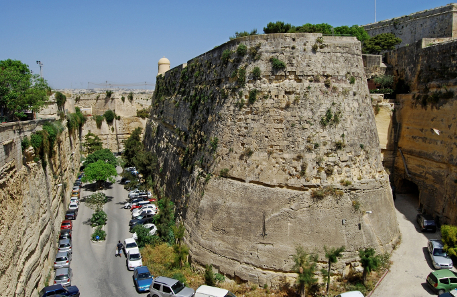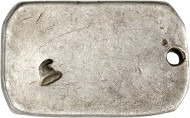On June 9, 1798, the French fleet anchored near Malta. Strictly speaking, it was on its way to Egypt. While you are at it why not conquer Malta as well, at least when you are a commander like Napoleon Bonaparte? He did so without a single shot. The French Hospitallers ran over to him. So the last Grand Master of the Order went into exile, accompanied by 16 knights only. The French assumed control and immediately introduced the achievements of the French Revolution.
Part of these achievements was the dispossession of the nobility and the clerical institutions whose revenues were taken to fund Napoleon’s Egyptian campaign. The Maltese were particularly unhappy with the latter. Then the trade in cotton, Malta’s main export product, came to a halt. The cotton had been shipped mainly to England, but England had become a wartime enemy. The Maltese gradually realized what it was like to be ruled by the French.
Bastion of Valletta. Photo: Felix König / Wikipedia.
They were not willing to accept this. The result was a revolt. September 2, 1798, that was the date an auction sale of church property in Mdina was scheduled for. Not only potential bidders showed up but many Maltese people as well who protested against the church property being bartered off. A 12 year-old boy is said to have thrown the first stone. That, however, may well be a local legend. Anyhow, after only a couple of days thousands of Maltese had driven back the small French garrison to Valletta.
Thanks to the Knights of the Order, Valletta possessed strong fortifications. On the other side there were the besiegers who had just 23 canons to storm the strong walls of Valletta. The rebels soon realized that they needed help. This help was provided by the British. No quick success was achieved, though. That may have been due to the fact that English Admiral Lord Horatio Nelson didn’t really feel like taking care of the matter himself. He preferred to be pampered by enchanting Lady Hamilton in the Kingdom of the Two Sicilies.
Admiral Alexander John Ball (1757-1809), painting by Henry William Pickersgill / Wikipedia.
Nelson sent his adjutant, Alexander Ball, an upright and smart advocate of British interests. He found himself facing not just a difficult military situation but a diplomatic conflict that seemed almost impossible to solve: the feudal lord of the fled Knights of the Order was the King of Naples. He was an ally of England. Thus, even if the French occupying troops had successfully been expelled from Valletta, it was not yet clear who could govern the island instead. While the Maltese would have loved to become the subject of British dominion, Lord Nelson thought different, or, as he wrote to Ball: “Respecting the situation of Malta with the King of Naples, it is this – he is the legitimate Sovereign of the Island: therefore, I am of opinion his Flag should fly.”
Malta under French siege, 1798-1800. Silver ingot of 30 tari 1800, Valletta. Maltese cross, on both sides split signature R-F (= République française), on top mark of value t(ari) – 30, below cipher of year 1800. With countermark on reverse: Phrygian cap. Restelli pl. XC, nr. 2 (this specimen). Auction Künker 261 (March 11/12, 2015), 5794, estimated at 75,000 euros.
It was convenient that the siege of Valletta extended. A numismatic testimony of this era is a silver ingot in the weight of 30 tari that was produced by the French during the siege. There was plenty of silver in the fortress, thanks to the looting of the church treasures. Accordingly, the French mint master Joseph Lebrun was able to mint several thousands of siege coins between 1799 and 1800. Only a handful of them have survived, though, of which as few as five bear the date 1800.
That it was still possible in 1799 to buy food with money is evidenced by some prices from that time. A boiling hen, therefore, cost 16 francs, a rabbit 12 francs, an egg 20 sous and a rat 40 sous.
By the way, Nelson came to see the battlefield after all, on April 23, 1800. With him traveled his beloved Lady Hamilton. The ship stopped in Syracuse, went on to Valletta only to come under fire – who would have thought it? Nelson immediately turned his sailing ship around, against the superior officer’s express order.
Thus, the final surrender of the French was not declared until September 3, 1800. The reason wasn’t any kind of military event but the simple fact that all rats, cats and dogs of the city had been eaten and 100 people died of starvation every day.
The British negotiated directly with the French, without involving the Maltese. Due to the French surrender they gained command over the island and therefore control over a major part of the Mediterranean Sea which led to the re-capture of Egypt already in 1801. The Congress of Vienna confirmed the British claim to Malta.
With Malta, Great Britain had got itself another colony. The Maltese people became independent as late as 1964, after a referendum. The British legacy is still ever-present on this island – if nothing else, when the continental European struggles with the general cussedness of left-hand driving.
If you are interested in the coin featured in this article, you can go directly to the Künker Spring Auction Sale, where they are on offer.
We also can offer an auction preview for the upcoming Künker sale.







